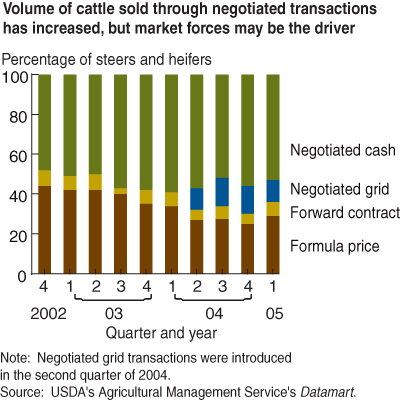Mandatory Livestock Price Reporting: More Transparent?
- by Janet Perry and James M. MacDonald
- 11/1/2005
The USDA Market News program aims to aid the efficient marketing of agricultural commodities by providing the public with price and sales information drawn from transactions around the country. But fundamental changes in livestock industries called into question the effectiveness of Market News reporting for livestock and led to a major redesign of the program through the Livestock Mandatory Reporting Act of 1999 (LMR). A recent ERS report reviews developments leading up to the Act and assesses its impact on cattle markets after implementation in 2001.
Before 2001, USDA Market News reporters gathered data voluntarily submitted by market participants and by observation at public markets. But more and more livestock are now being marketed under contract arrangements that often bind producers and packers to formal long-term relationships and set sales terms well before delivery of the animals for slaughter. Because contract terms were rarely reported under the voluntary system, USDA’s Market News reports of the late 1990s were based on a declining number of transactions. Producers expressed concern that unreported contract prices were substantially higher than the cash prices reported in Market News and that Market News prices based on a small number of transactions could be more easily manipulated. Some feared that cash markets for livestock would disappear without timely, comprehensive, and accurate price reporting. Because many contracts base payments on cash market prices, cash market erosion concerned all market participants.
Under LMR, large meatpackers electronically file summary information on all transactions twice a day, and USDA compiles the information in its Market News reports. By early 2002, the program was capturing more than 90 percent of all cattle sales, compared with less than 60 percent in the last days of the voluntary system. LMR enables users to compare prices for cattle sold under different marketing methods. It appears that, for cattle of similar quality, prices in negotiated spot market transactions closely track prices for cattle sold under contracts. In other words, producers selling under contract do not seem to realize a significant price advantage.
Many producers initially expressed disappointment with LMR, partly because of implementation problems and partly because the data did not show that contract prices were higher. But producers now appear to be using the cash market more: After 2002, cattle sales shifted away from contracts and toward negotiated cash market transactions. While that shift may have been driven by other market developments—such as low inventories and strong demand—that raised all cattle prices, it also may have been affected by expanded and more transparent price reporting under LMR.
This article is drawn from:
- Perry, J., MacDonald, J.M., Nelson, K., Hahn, W. & Arnade, C. (2005). Did the Mandatory Requirement Aid the Market? Impact of the Livestock Mandatory Reporting Act. U.S. Department of Agriculture, Economic Research Service. LDPM-13501.


